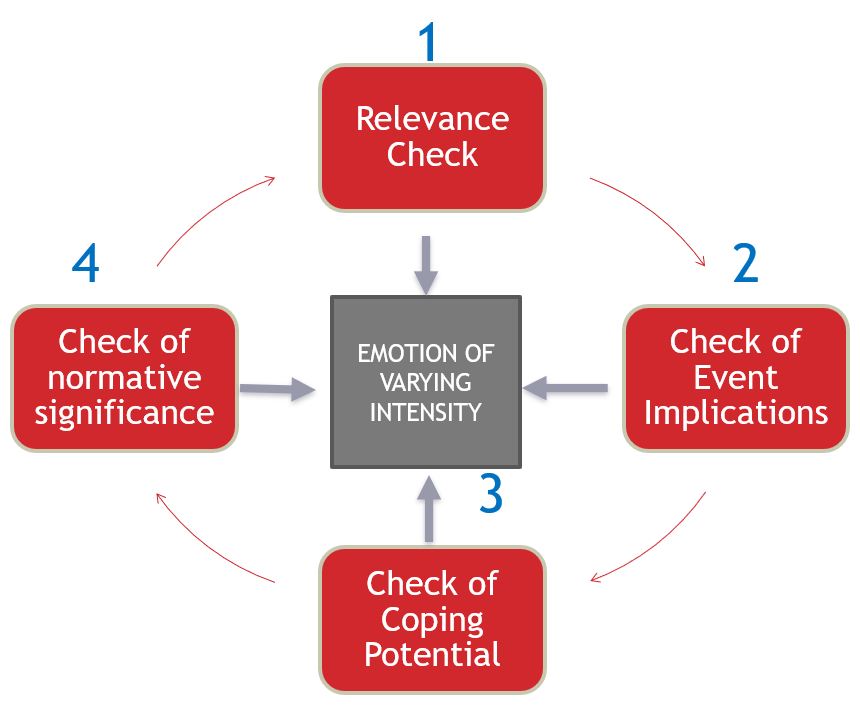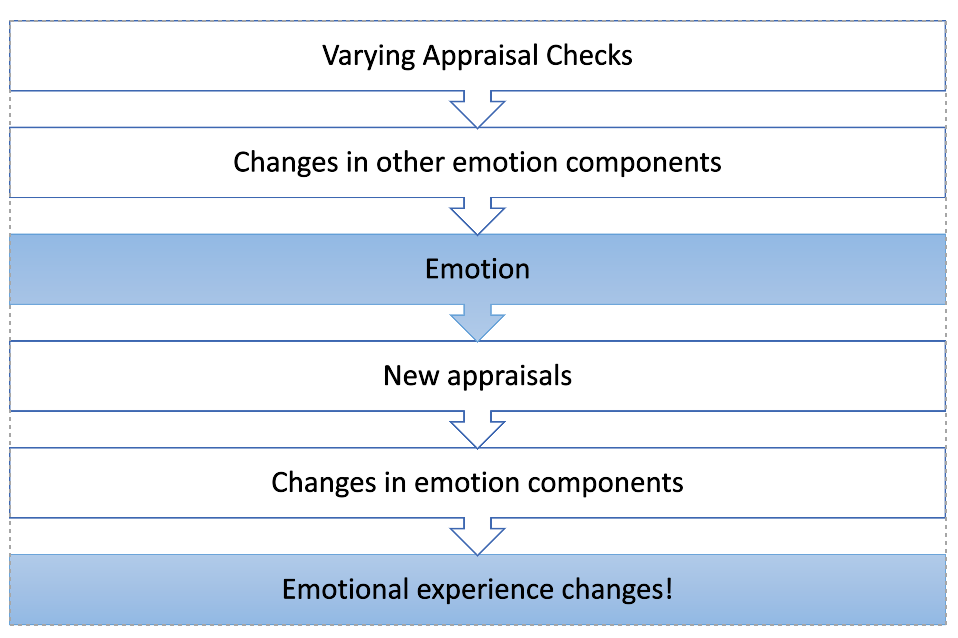Chapter 4: Cognitive Appraisal Theory
Component Process Model (CPM; Scherer, 2001)
Turns out, both theorists are somewhat right. The current thought is that cognitive appraisals which developed earlier in our ancestral past might be universal. These cognitive appraisals are the less complex appraisals, such as pleasantness and novelty. Theorists believe that cognitive appraisals that developed more recently, such as immorality and responsibility, are those that show cultural differences. For instance, Scherer (1997) found that across emotions, African residents reported more immorality, whereas Latin American residents reported more morality.
Klaus Scherer developed a cognitive appraisal model called the Component Process Model (CPM; Scherer, 2001). The CPM is founded on evolutionary theory and thus views each appraisal as having evolutionary significance (e.g., preventing death, advancing reproductive goals). The CPM states that cognitive appraisal is a process in which we continuously appraise and reappraise our environment. Each time we appraise or reappraise, the new interpretation could change our emotional experience (see Figure 1).
Figure 1
Influence of Appraisals on Emotion Experience
The CPM divides appraisal into four different stages: 1) relevance check, 2) implications check 3) coping potential check, and 4) normative significance evaluation. Stage 1 occurs earliest in the emotional experience, whereas check 4 occurs last. At each step, several cognitive appraisal dimensions occur, with step 1 including the more primitive, universal appraisals and step 4 including the later, more cultural appraisals. Figure 2 shows the four appraisal checks. Each appraisal check contains specific cognitive appraisal dimensions, which Scherer (2001) terms “stimulus evaluation checks” (SECs; p. 94). Table 1 shows the four appraisal checks and the SECs subsumed in each appraisal check.
Scherer views these SECs as the minimum appraisal people must make to distinguish their emotional experiences and to label their emotions. These SECs should be viewed as dimensional and not categorical. This means each SEC ranges from low to high scores with scores anywhere in the middle. Scherer proposes that the emotion label and felt intensity depend on the pattern of SECs that occur during the emotion. Thus, people cannot make one cognitive appraisal and determine their emotion – they must consider all their evaluations together. In the following sections, we will explain each check.
Figure 2
Component Process Model (CPM) Appraisal Checks

Table 1
CPM Appraisal checks and corresponding stimulus evaluation checks (SECs)
Appraisal Check |
Information Assessed during Appraisal |
SECs |
|---|---|---|
Relevance |
How relevant is this event for me?
Does it directly affect me or my social group? |
Novelty
Pleasantness Goal Relevance |
Implications |
What are the implications or consequences of this event?
How do these implications affect my well-being? How do these implications affect my short or long-term goals? |
Causal Attribution
Possible Outcomes Goal Conduciveness Urgency |
Coping Potential |
How well can I cope with or adjust to these consequences | Controllability
Power/Resources Coping Potential |
Normative Significance Evaluation |
What is the significance of this event with respect to my self-concept and social norms and values? | Internal Standards Check
External Standards Check |
Adapted from “Appraisal Considered as a Process of Multilevel Sequential Checking.,” by K.R. Scherer, 2001, In K.R. Scherer, A. Schorr, & T. Johnstone (Eds.), Appraisal processes in emotion: Theory, methods, research, p. 94, Copyright 2001 Oxford University Press


